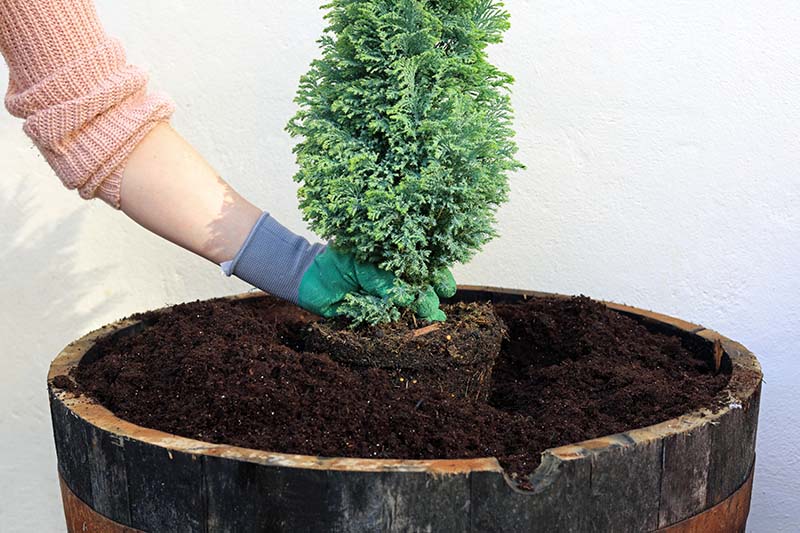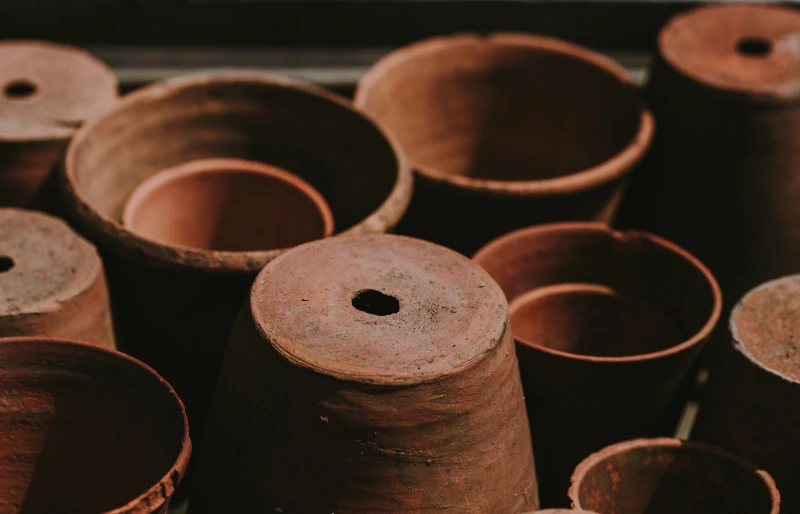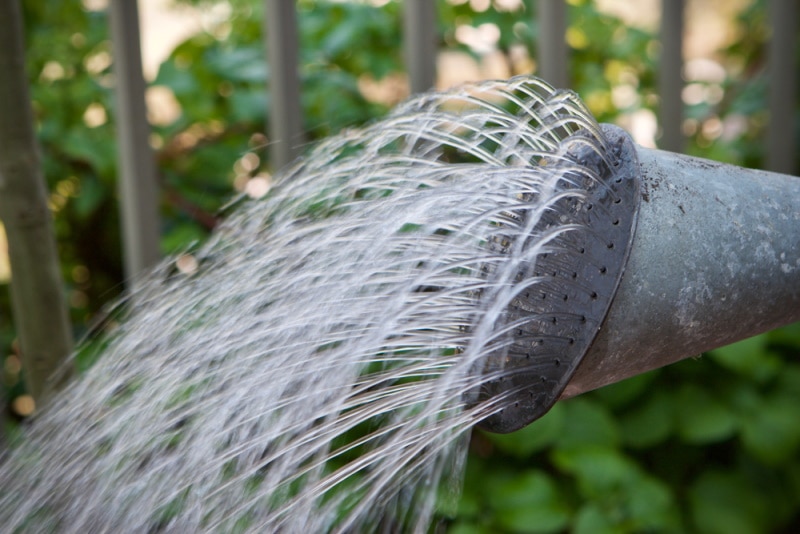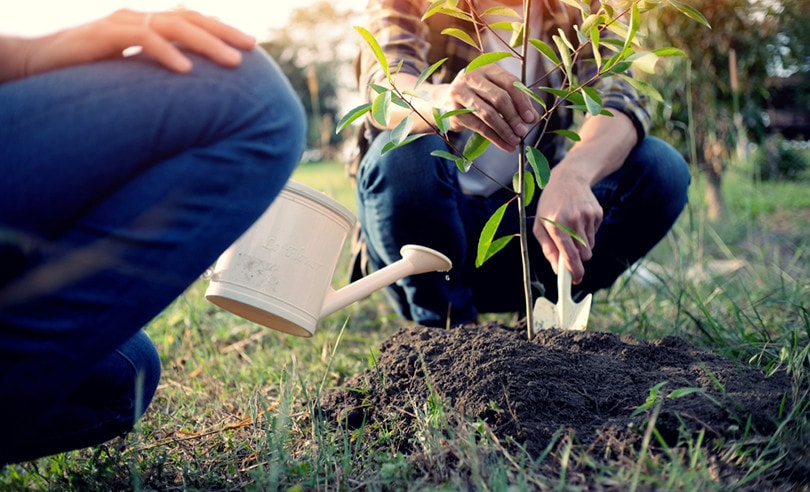How to Grow a Tree in Potting Soil — 4 Simple Steps
-
Pete Ortiz
- Last updated:

Potting soil is a unique soil mix ideal for plants grown in containers. It has just the proper nutrients to make plants grow and mature faster. Like flowers, some trees thrive in containers because they grow slowly, have fibrous roots, and remain relatively small even when mature. These trees include dwarf conifers, star magnolias, Redbuds, Japanese flowering cherries, etc.
But can you plant trees in potting soil? Yes and no. There are numerous aspects you must take into account before planting a tree in potting soil. Read on to find out how growing trees in potting soil works, what to consider, and how to give planted trees the best odds of thriving.
The 4 Steps to Grow Trees in Potting Soil
Growing trees in containers is a popular trend, especially in neighborhoods with little or no outdoor space. A tree growing in potting soil can be placed on your balcony, patio, or porch to turn dull areas into interesting focal points.
Here is how to grow a tree in potting soil.
1. Choose the Right Tree Species

For a tree to thrive in potting soil, it must be hardy enough to establish itself in a container. Unlike trees growing in the ground, their counterparts in planters have limited soil and are also subjected to extreme temperatures.
Consider the mature size of different tree species and their preferred growing requirements. Generally, dwarf trees and species that are relatively small when mature make excellent candidates for growing in planters.
Some of the best tree species to plant in potting soil include but are not limited to the following:
- Japanese maple
- Crepe myrtle
- Dwarf camellias
- Black Dragon
- Fiddle leaf fig
- Fastigiate hornbeams
- Staghorn sumac
2. Select an Ideal Container/ Planter

Based on the tree species you choose, you should select a planter depending on how deep the roots will grow. A bigger container is necessary if your tree has an extensive root system. Also, consider the mature size of your tree species. You need a container that can hold enough soil to keep it firm even if it grows to its maximum height.
Some of the best planter materials include fiberglass, high-grade plastic, wood, and cast concrete. Fiberglass plant pots are a top choice for many because they are weatherproof and fade-resistant. Make sure the planter you choose and its positioning allow proper drainage to prevent the potting soil from becoming waterlogged¹. The ideal placement spot should receive at least six hours of sunlight.
As a general rule, opt for the largest planting pot possible. This will also ensure you don’t have difficulty ascertaining that your tree has adequate food and water. Your planter box should be at least double the depth and width of the mature root ball of your tree species.
Opting for a smaller planter box is fine, especially when planting tree seedlings. However, prepare to transfer the trees to larger containers after every 2 to 3 years.
3. Watering & Mulching

Trees growing in potting soil require more frequent watering than those growing in the ground. The ideal amount of watering will depend on various factors, including the weather conditions and whether your tree receives adequate sunshine.
Ideally, it would be best if you watered twice weekly or more frequently during hot months. Water thoroughly until water drains from the potting soil, and wait until it dries up completely before you water again.
Also, add a layer of mulch to help the soil retain moisture and prevent weed growth.
4. Fertilizer Application

Trees, including those growing in potting soil, need minimal feeding. The idea is only to provide the nutrients that could be missing from the potting soil. Still, fertilizer application is necessary, especially during peak growth cycles in spring.
For the best outcome, use organic or slow-release fertilizers rich in phosphorus. Adding fertilizer to the potting soil at least once every two weeks ensures proper root development. This also enhances the odds of your trees growing to their full potential.
How to Transplant a Tree in Potting Soil to the Ground
Some tree species can live a long, healthy, and happy life in a planter. Some varieties can thrive in potting soil for over two decades before they require repotting. Typically, even trees that thrive in planters need to be transferred to the ground at some point. The switch is necessary to allow them to grow taller and stronger.
Here are the steps to take when transplanting a tree in potting soil to the ground.
1. Dig a Hole

When transplanting a tree from a container to the ground, dig a hole at least three times wider than your potting container. Also, ensure the hole is only deep enough for the root collar to be right at the top of your covered hole.
2. Prepare Your Tree for Transplanting
Loosen the soil around the edges of your planter and carefully slide the tree out with its roots intact. If the roots have formed a root ball, you need to root prune¹ your tree. Use a sharp knife to cut an “X” below the root ball and four vertical cuts on the sides.
Carefully place the tree at the center of the hole and maintain as much potting soil as possible.
3. Fill the Hole

You need to use all the original potting soil when transplanting your tree. Also, use ground soil to ensure your tree maintains a straight position and is firmly in the ground.
4. Water the Tree
Your newly transplanted tree needs consistent moisture during its first year. Ensure you do not overwater because the soggy ground can cause root rot. You can ensure the plant has proper moisture even during the dry seasons by adding 2 to 4 inches of mulch.
Final Thoughts
Trees can add a unique wilderness appeal to any landscape. Growing them in containers makes adding color and texture to your outdoors easier. Potting soil is nutrient-rich and can give your young trees maximum chances of developing to their full potential. The soil works best for seedlings or smaller tree species.
If you purchase a larger tree species from a nursery, you will, at some point, need to transfer it from the potting soil to the ground. This will give it a better chance of survival by encouraging the growth of a complex root network.
- https://www.arborday.org/trees/planting/containerized.cfm
- https://www.washingtonpost.com/lifestyle/home/why-every-garden-should-have-a-container-tree-and-how-to-grow-them/2018/11/05/162849ac-dc6e-11e8-85df-7a6b4d25cfbb_story.html
- https://extension.umd.edu/resource/tree-problems-caused-excess-water
- https://jayscotts.com/blog/growing-trees-in-pots/#:~:text=Remove%20your%20tree%20out%20of,the%20roots%20are%20completely%20covered.
Featured Image Credit: Dean Clarke, Shutterstock
Contents



